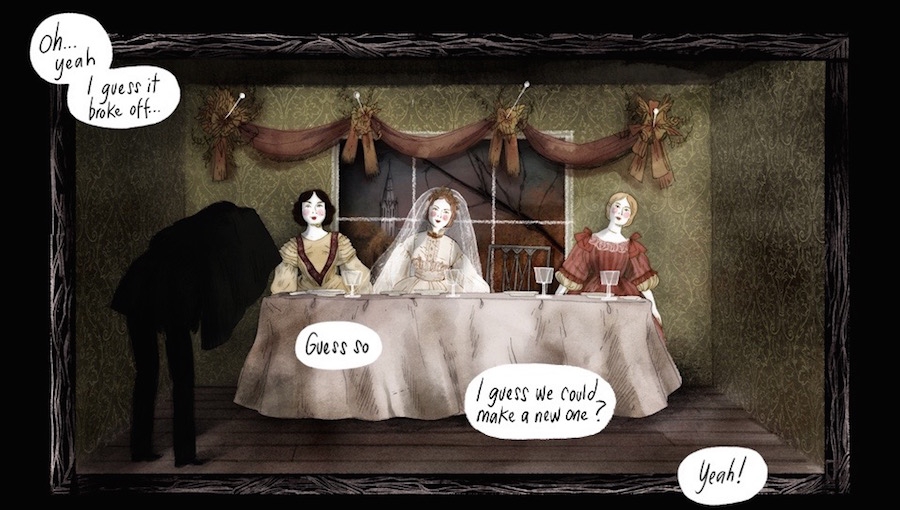As Halloween is fast approaching, the Fanbase Press staff and contributors decided that there was no better way to celebrate this horrifically haunting holiday than by sharing our favorite scary stories! Be they movies, TV shows, video games, novels, or any other form of entertainment, members of the Fanbase Press crew will be sharing their “scariest” stories each day leading up to Halloween. We hope that you will enjoy this sneak peek into the terrors that frighten Fanbase Press!
If you love fables, spooky folklore, and body horror, you should really consider checking out Emily Carroll’s comics, which are available in both print (Her collection of short horror stories, Through the Woods, is especially excellent.) and online. Carroll’s horror comics read something like if Emily Dickenson reworked Angela Carter’s The Bloody Chamber, but with pictures. The stories are dark, and the images beautifully rendered. Carroll varies her drawing style slightly according to the content that each comic explores. So, her body horror comics feature bodies drawn with lines that transform from soft, rounded edges to lines that appear to be melting, or even dripping, while her psychological drama comics use sharper, more rigid shapes.
Carroll is a bit of a digital native; her work appeared online before it was ever in print, and it is in the realm of the Internet comic that she really honed her skills. While you’ll find comics that run the range of Carroll’s skills on her website, I want to highlight two comics that are especially scary: The Groom and Some Other Animal’s Meat. Both of these comics appear to have been written with an Internet reading experience in mind, and so utilise the extra “page” length that comes with reading on a scrolling-based medium. And, it is the scrolling itself that enables Carroll to build the particular suspense that makes her work so spooky. One narrative structure that Carroll uses to engage her reader is that while she very strongly implies events and correlations with horrifying consequences, she often doesn’t actually depict those moments.
In The Groom, two little girls find an extremely well-put-together diorama that depicts a wedding banquet. Carroll sets up a creepy dissonance immediately in three ways: the diorama itself is portrayed in colour where the rest of the comic is in black and white and is slightly more realistic in its styling than the world of the girls; the camera is missing, and the photographer stoops over an empty space; and, finally, the groom is absent. Before any action proceeds, the diorama is shrouded in an aura of mystery; the girls find it behind a home in their neighbourhood where they often find trash and other discarded objects, and the scene depicted is familiar to the girls, who are able to identify a specific church that appears through a window of the diorama. The girls’ interest in the diorama grows steadily until it absorbs their full attention, rising to the level of obsession. While this is happening, strange events begin to unfold in their lives in a an eerie parallel, culminating when one of the girls pricks her finger on the pipe-cleaner groom they’ve fashioned to fill out the wedding party. This is the unstated horror at the core of the comic; does the groom, who had started disappearing from the diorama and appearing in strange places just days before, attack the girls, or is the whole thing an unhappy accident? The reader is left to decide for herself, though the girls do change their tune on the diorama following the event, seemingly afraid of it. This is literally the scariest thing about this comic and, I promise, it plays out beautifully. You’ll be thinking about the darned diorama (and the possibility of its being haunted) for weeks.
Some Other Animal’s Meat approaches horror similarly, through unknowns and absences. A woman sells lotions and beauty products to her friends but doesn’t use the products on herself. In this comic, the horror element lies somewhere between the unknown factor of the beauty products (Are they, as the protagonist seems to imagine, disfiguring?) and Carroll’s rendering of disfigured bodies: bodies appear to self-deconstruct, melting from the outside in. Especially horrific is that the reader is never certain whether the disfiguring effect (real or imagined) is the source of the protagonist’s pain (She clearly carries a burden of anxiety and possibly agoraphobia.), or whether the disfigurement is the manifestation of a deeper fear, perhaps at the possibility that she’s been selling a slow-acting poison to her loved ones. The final effect is one of loneliness: The protagonist, debilitated by her anxiety, lies in bed alone, curled up on her side.
Both of these comics had a profound and lasting effect on me, the first because it frames the possibility of haunting in such an eerie, believable way, and the second because it deals with the horrors of structures that we encounter daily, or with the small violences that we exchange with each other in the name of economic gain or beauty. Carroll’s work often weaves cultural critique of this kind – explorations of the place where community and relationships meet up with myths and fables – into comics that are also simply good stories.

